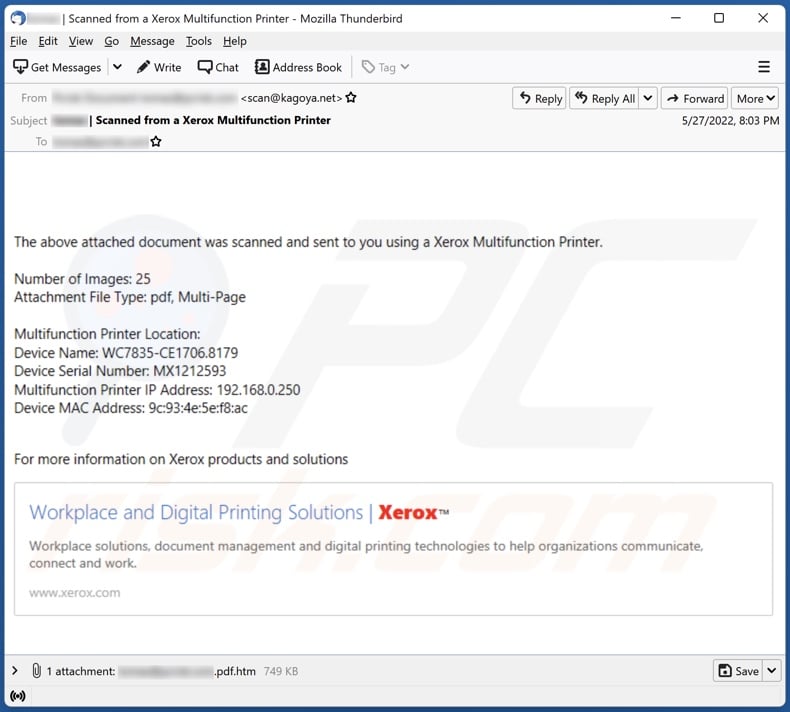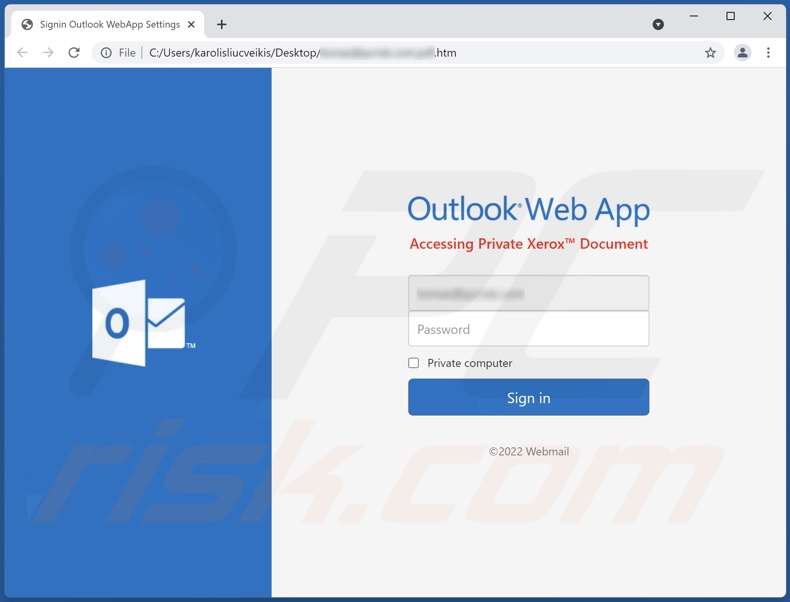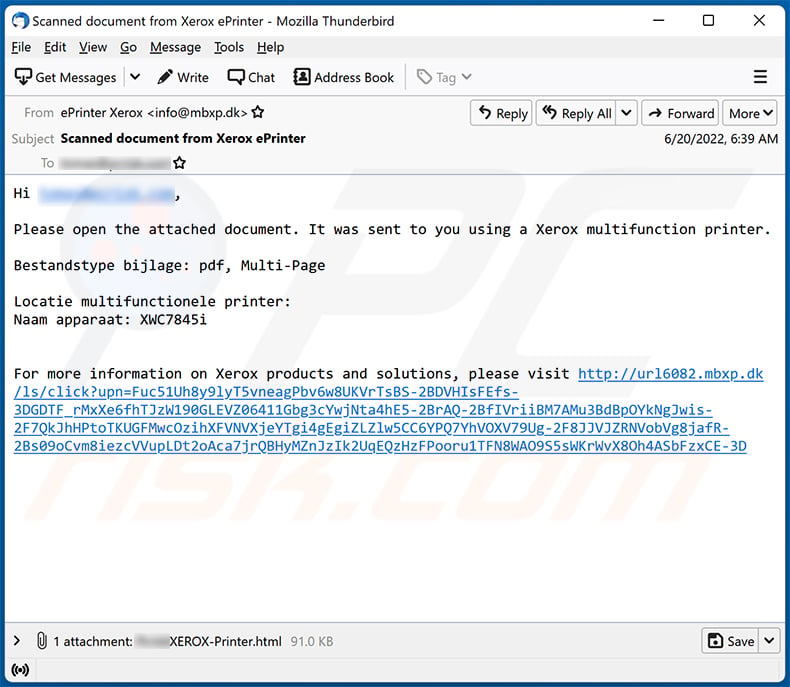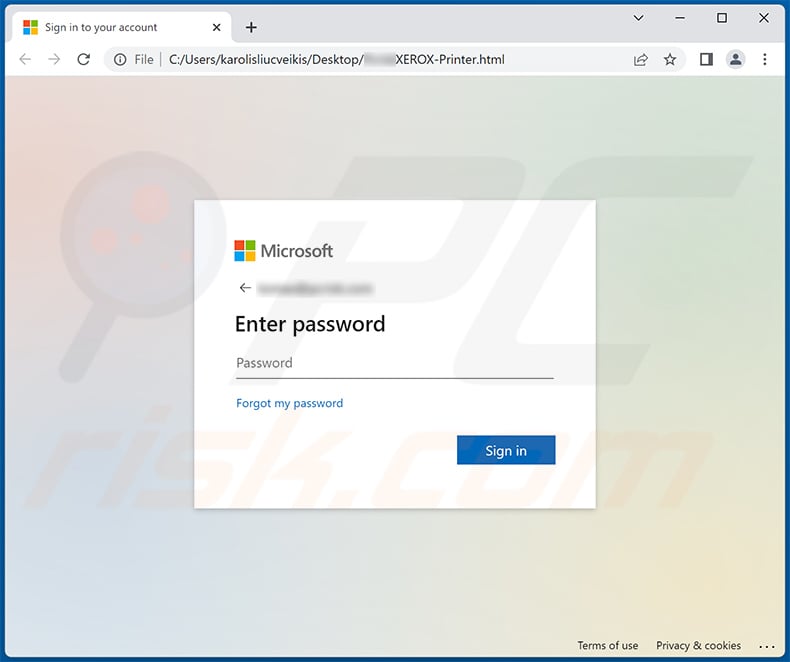Avoid getting scammed by fake "Xerox Multifunction Printer" emails
Phishing/ScamAlso Known As: Xerox Multifunction Printer phishing email
Get free scan and check if your device is infected.
Remove it nowTo use full-featured product, you have to purchase a license for Combo Cleaner. Seven days free trial available. Combo Cleaner is owned and operated by RCS LT, the parent company of PCRisk.com.
What kind of email is "Xerox Multifunction Printer"?
Our analysis of the "Xerox Multifunction Printer" email revealed that is spam operating as a phishing scam. This letter attempts to deceive recipients into providing their email account log-in credentials by claiming that they were sent a document through a service of Xerox.
It must be emphasized that these emails are fake, and they are in no way associated with the legitimate Xerox Holdings Corporation.

"Xerox Multifunction Printer" email scam overview
The spam email claims to have a document scanned using the "Xerox Multifunction Printer" attached to it. The letter states that the attachment is a multi-page PDF document and provides the printer's device data. As mentioned in the introduction, this fake email is not associated with Xerox.
When recipients open the attached HTML file - they are presented with a fake Outlook log-in page. This sign-in page states that the user is "Accessing Private Xerox™ Document", however, any email account log-in credentials (emails addresses/ passwords) entered into it will be disclosed to the scammers behind the spam campaign. With this information in their possession, the cyber criminals can steal the exposed email account and potentially the content associated with it.
To elaborate, criminals can gain access to other social accounts (e.g., social networking/media, messengers, etc.) registered with the email. The communication platforms can be used to ask the contacts/friends for loans or to spread malware by sharing malicious files/links - all under the guise of the account's genuine owner.
Cyber criminals may also gain control over finance-related accounts like online banking, digital wallets, e-commerce, and so on. They can use these accounts to make fraudulent transactions and online purchases.
To summarize, victims of phishing scams like "Xerox Multifunction Printer" - can experience severe privacy issues, financial losses, and identity theft.
| Name | Xerox Multifunction Printer phishing email |
| Threat Type | Phishing, Scam, Social Engineering, Fraud |
| Fake Claim | Multi-page document was scanned and sent to the recipient. |
| Disguise | The fake document was sent using a service supposedly provided by Xerox. |
| Detection Names (attachment) | Combo Cleaner (JS:Trojan.Cryxos.9352), Emsisoft (JS:Trojan.Cryxos.9352 (B)), ESET-NOD32 (HTML/Phishing.Gen), Fortinet (JS/Phishing.6EEF!tr), GData (JS:Trojan.Cryxos.9352), Full List Of Detections (VirusTotal) |
| Symptoms | Unauthorized online purchases, changed online account passwords, identity theft, illegal access of the computer. |
| Distribution methods | Deceptive emails, rogue online pop-up ads, search engine poisoning techniques, misspelled domains. |
| Damage | Loss of sensitive private information, monetary loss, identity theft. |
| Malware Removal (Windows) |
To eliminate possible malware infections, scan your computer with legitimate antivirus software. Our security researchers recommend using Combo Cleaner. Download Combo CleanerTo use full-featured product, you have to purchase a license for Combo Cleaner. 7 days free trial available. Combo Cleaner is owned and operated by RCS LT, the parent company of PCRisk.com. |
Spam campaigns in general
We have analyzed countless phishing emails; "Servicio De Administración Tributaria email scam", "YOUR MAILBOX IS OUTDATED", and "Coca Cola Lottery email scam" are merely a couple of examples.
These letters can target a wide variety of information, ranging from account log-in credentials to personally identifiable details (e.g., names, surnames, addresses, etc.). Spam letters are employed to facilitate various scams. These emails are also used to proliferate trojans, ransomware, cryptominers, and other malware.
How do spam campaigns infect computers?
Spam emails can have virulent files attached to them. Alternatively, these letters can contain links to malicious websites, which can be capable of stealthily downloading/installing malware or tricking users into doing so themselves.
Virulent files can be executables, archives, PDF and Microsoft Office documents, JavaScript, etc. Once an infectious file is executed, run, or otherwise opened - the infection process is triggered. For example, Microsoft Office documents infect systems by executing malicious macro commands.
How to avoid installation of malware?
We strongly advise exercising caution with incoming mail. The attachments or links present in suspicious/irrelevant emails must not be opened - since that may lead to a system infection. Additionally, it is important to use Microsoft Office versions released after 2010 since they have the "Protected View" mode that prevents automatic execution of macros.
However, malware is not spread exclusively through spam mail. Therefore, we also recommend downloading only from official/verified channels and activating/updating software with tools provided by genuine developers.
We must emphasize the importance of having a dependable anti-virus installed and updated. Security software has to be used to run regular system scans and to remove detected threats/issues. If you've already opened malicious attachments, we recommend running a scan with Combo Cleaner Antivirus for Windows to automatically eliminate infiltrated malware.
Text presented in the "Xerox Multifunction Printer" email letter:
Subject: - | Scanned from a Xerox Multifunction Printer
The above attached document was scanned and sent to you using a Xerox Multifunction Printer.
Number of Images: 25
Attachment File Type: pdf, Multi-Page
Multifunction Printer Location:
Device Name: WC7835-CE1706.8179
Device Serial Number: MX1212593
Multifunction Printer IP Address: 192.168.0.250
Device MAC Address: 9c:93:4e:5e:f8:ac
For more information on Xerox products and solutions
Workplace and Digital Printing Solutions | Xerox
Workplace solutions, document management and digital printing technologies to help organizations communicate, connect and work.
www.xerox.com
Screenshot of the phishing HTML file distributed by the "Xerox Multifunction Printer" spam campaign:

Another example of Xerox multifunction printer-themed spam email spreading an HTLM document designed for phishing purposes:

Text presented within:
Subject: Scanned document from Xerox ePrinter
Hi -,Please open the attached document. It was sent to you using a Xerox multifunction printer.
Bestandstype bijlage: pdf, Multi-Page
Locatie multifunctionele printer:
Naam apparaat: XWC7845i
For more information on Xerox products and solutions, please visit
-
Screenshot of the attached HTML document:

Instant automatic malware removal:
Manual threat removal might be a lengthy and complicated process that requires advanced IT skills. Combo Cleaner is a professional automatic malware removal tool that is recommended to get rid of malware. Download it by clicking the button below:
DOWNLOAD Combo CleanerBy downloading any software listed on this website you agree to our Privacy Policy and Terms of Use. To use full-featured product, you have to purchase a license for Combo Cleaner. 7 days free trial available. Combo Cleaner is owned and operated by RCS LT, the parent company of PCRisk.com.
Quick menu:
- What is Xerox Multifunction Printer phishing email?
- Types of malicious emails.
- How to spot a malicious email?
- What to do if you fell for an email scam?
Types of malicious emails:
![]() Phishing Emails
Phishing Emails
Most commonly, cybercriminals use deceptive emails to trick Internet users into giving away their sensitive private information, for example, login information for various online services, email accounts, or online banking information.
Such attacks are called phishing. In a phishing attack, cybercriminals usually send an email message with some popular service logo (for example, Microsoft, DHL, Amazon, Netflix), create urgency (wrong shipping address, expired password, etc.), and place a link which they hope their potential victims will click on.
After clicking the link presented in such email message, victims are redirected to a fake website that looks identical or extremely similar to the original one. Victims are then asked to enter their password, credit card details, or some other information that gets stolen by cybercriminals.
![]() Emails with Malicious Attachments
Emails with Malicious Attachments
Another popular attack vector is email spam with malicious attachments that infect users' computers with malware. Malicious attachments usually carry trojans that are capable of stealing passwords, banking information, and other sensitive information.
In such attacks, cybercriminals' main goal is to trick their potential victims into opening an infected email attachment. To achieve this goal, email messages usually talk about recently received invoices, faxes, or voice messages.
If a potential victim falls for the lure and opens the attachment, their computers get infected, and cybercriminals can collect a lot of sensitive information.
While it's a more complicated method to steal personal information (spam filters and antivirus programs usually detect such attempts), if successful, cybercriminals can get a much wider array of data and can collect information for a long period of time.
![]() Sextortion Emails
Sextortion Emails
This is a type of phishing. In this case, users receive an email claiming that a cybercriminal could access the webcam of the potential victim and has a video recording of one's masturbation.
To get rid of the video, victims are asked to pay a ransom (usually using Bitcoin or another cryptocurrency). Nevertheless, all of these claims are false - users who receive such emails should ignore and delete them.
How to spot a malicious email?
While cyber criminals try to make their lure emails look trustworthy, here are some things that you should look for when trying to spot a phishing email:
- Check the sender's ("from") email address: Hover your mouse over the "from" address and check if it's legitimate. For example, if you received an email from Microsoft, be sure to check if the email address is @microsoft.com and not something suspicious like @m1crosoft.com, @microsfot.com, @account-security-noreply.com, etc.
- Check for generic greetings: If the greeting in the email is "Dear user", "Dear @youremail.com", "Dear valued customer", this should raise suspiciousness. Most commonly, companies call you by your name. Lack of this information could signal a phishing attempt.
- Check the links in the email: Hover your mouse over the link presented in the email, if the link that appears seems suspicious, don't click it. For example, if you received an email from Microsoft and the link in the email shows that it will go to firebasestorage.googleapis.com/v0... you shouldn't trust it. It's best not to click any links in the emails but to visit the company website that sent you the email in the first place.
- Don't blindly trust email attachments: Most commonly, legitimate companies will ask you to log in to their website and to view any documents there; if you received an email with an attachment, it's a good idea to scan it with an antivirus application. Infected email attachments are a common attack vector used by cybercriminals.
To minimise the risk of opening phishing and malicious emails we recommend using Combo Cleaner Antivirus for Windows.
Example of a spam email:

What to do if you fell for an email scam?
- If you clicked on a link in a phishing email and entered your password - be sure to change your password as soon as possible. Usually, cybercriminals collect stolen credentials and then sell them to other groups that use them for malicious purposes. If you change your password in a timely manner, there's a chance that criminals won't have enough time to do any damage.
- If you entered your credit card information - contact your bank as soon as possible and explain the situation. There's a good chance that you will need to cancel your compromised credit card and get a new one.
- If you see any signs of identity theft - you should immediately contact the Federal Trade Commission. This institution will collect information about your situation and create a personal recovery plan.
- If you opened a malicious attachment - your computer is probably infected, you should scan it with a reputable antivirus application. For this purpose, we recommend using Combo Cleaner Antivirus for Windows.
- Help other Internet users - report phishing emails to Anti-Phishing Working Group, FBI’s Internet Crime Complaint Center, National Fraud Information Center and U.S. Department of Justice.
Frequently Asked Questions (FAQ)
Why did I receive this email?
Spam emails are not personal. Cyber criminals distribute these letters in mass-scale operations with the hopes that at least some of the recipients will be tricked by their scams.
I have provided my personal information when tricked by this spam email, what should I do?
If you have provided log-in credentials - immediately change the passwords of all potentially exposed accounts and inform their official support. And if you have disclosed other private data (e.g., ID card details, credit card numbers, etc.) - contact the corresponding authorities without delay.
I have read a spam email but didn't open the attachment, is my computer infected?
No, opening a spam email will not trigger any malware download/installation processes. Infection chains are initiated when the malicious attachments or links present in these letters are opened/clicked.
I have downloaded and opened a file attached to a spam email, is my computer infected?
Whether an infection occurred can depend on the purpose of the file (e.g., phishing or malware download/installation) and its format. If the opened file was an executable (.exe, .run, etc.) - most likely, yes - your system was infected. However, document formats (.pdf, .xls, .doc, etc.) may require additional user interaction (e.g., enabling macro commands) to start downloading/installing malicious software.
Will Combo Cleaner remove malware infections present in email attachments?
Yes, Combo Cleaner can detect and eliminate nearly all known malware infections. It has to be mentioned that high-end malware tends to hide deep within systems. Therefore, running a complete system scan is a must.
Share:

Tomas Meskauskas
Expert security researcher, professional malware analyst
I am passionate about computer security and technology. I have an experience of over 10 years working in various companies related to computer technical issue solving and Internet security. I have been working as an author and editor for pcrisk.com since 2010. Follow me on Twitter and LinkedIn to stay informed about the latest online security threats.
PCrisk security portal is brought by a company RCS LT.
Joined forces of security researchers help educate computer users about the latest online security threats. More information about the company RCS LT.
Our malware removal guides are free. However, if you want to support us you can send us a donation.
DonatePCrisk security portal is brought by a company RCS LT.
Joined forces of security researchers help educate computer users about the latest online security threats. More information about the company RCS LT.
Our malware removal guides are free. However, if you want to support us you can send us a donation.
Donate
▼ Show Discussion